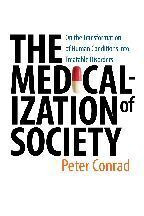
Reviews
This book's greatest achievement is its engaging style and clear location of scholarly analysis in a clinical context. Jutel never lets the reader forget why diagnosis matters, and she is skilled at making the invisible visible as she explores the myriad ways in which the mysterious process of classifying and naming illness informs the provision of healthcare.
A well-documented, carefully argued manuscript. Jutel's prose was easy to understand, and her book would be quite accessible to the interested lay reader.
This thought-provoking book will help all health professionals to become more aware of their communications with patients and families.
By focusing on the process of diagnostic determination, the author promotes the initial development of a theoretical platform for sociological study... An important resource for health care professionals, especially those in the social sciences.
Well written and a surprisingly pleasurable read. It gives the physician a glimpse at how this fundamental element to medicine—making a diagnosis—appears to those most affected by it—the patients. The book also reveals the ways society shapes our understanding of wellness and disease.
With this engaging and fascinating text, [Jutel] has presented a challenge which medical sociology can, and should, take on board.
The issues explored in Putting a Name to It, and the questions it raises, are of tremendous importance today, especially for those seeking diagnosis as a means for resources, or rejecting diagnosis' judgments of normativity.
This book provides a detailed and comprehesive framework for the emerging sub discipline of medical sociology. From a social work perspective, the book was enlightening because of the overview provided on how the classification and framing of diagnosis relate to social order and status... Reading this book was a helpful experience.
Where one could have expected the author to suffice herself with an analysis of social framing and discourse, she brings St. Augustine alongside sociologist Peter Conrad and art history alongside evidence-based-medicine. Jutel joins new research with classical themes and weaves them all in a colorful and detailed tapestry, thus forming a seducing conceptual and theoretical ground for further work.
Readers will continue thinking about the content well after the book is read. The book is written in one voice that beautifully weaves a single thread of thought about various social aspects of medical diagnosis. The author provides insights about what many may view as a one-dimensional concept and exposes its multidimensional, social nature.
Part meditation, part programmatic statement, part intimate reflection, part analytical call to arms, and part sprawling literature review, this accessible book can be read differently by different audiences... with each picking up invaluable insights resonant to their particular interests... Bursting with insights, the book's true orientation is toward the future. Jutel is not interested in getting in the final word but rather raising provocative questions and suggesting opportunities for subsequent research. In this the book is an unqualified success.
Jutel joins new research with classical themes and weaves them all in a colorful and detailed tapestry, thus forming a seducing conceptual and theoretical ground for further work.
[The book's] use of interesting and detailed examples... often convincingly contributes to Jutel's overall argument on diagnoses.
Putting a Name to It is a leap forward in understanding the importance of diagnosis. This most ordinary of activities is surprisingly complicated, shaped by political, economic, scientific, ethical, and cultural contexts. From clinical encounters to insurance reimbursements to social movements, diagnosis is very complex. Jutel’s synthesis, combined with interesting examples and lively theoretical approach, does a great job.
Lively, engaging, and conceptually innovative, this book makes a significant contribution to the sociology of health and illness. Hitherto, diagnosis so pivotal to medical practice has not received comprehensive analysis; Jutel’s text rectifies this. The combination of empirical examples and social theorizing makes this text a must read for sociologists who want to understand medical practice, medical work, and medical knowledge.
Eclectic and nuanced, Putting a Name to It effectively reveals the cultural complexity and sociological importance of diagnosis. Jutel's detailed and fascinating case studies skillfully and with considerable empathy capture the troubling world of people whose suffering cannot or will not be reduced to an agreed-upon mechanism.
Book Details
Foreword, by Peter Conrad
Preface
Introduction: What's in a Name?
A Place for a Sociology of Diagnosis?
An Avenue for Understanding
1. Lumping or Splitting: Classification in Medical Diagnosis
The Aims of
Foreword, by Peter Conrad
Preface
Introduction: What's in a Name?
A Place for a Sociology of Diagnosis?
An Avenue for Understanding
1. Lumping or Splitting: Classification in Medical Diagnosis
The Aims of Classification
Classification of Diseases
Classification Systems
Revealing Classificatory Politics in Diagnosis
2. Social Framing and Diagnosis: Corpulence and Fetal Death
Corpulence
Fetal Death
Frame and Be Framed
3. What's Wrong with Me? Diagnosis and the Patient-Doctor Relationship
Illness and Disease
Medical Authority
Changing Roles in Diagnosis
What Next?
4. Beyond Our Ken? Contested Diagnoses and the Medically Unexplained
Medically Unexplained Symptoms
Discovery of Disease
Whose Diagnosis?
Splitting from Diagnosis?
5. Driving Diagnosis: Peddlers and Pushers
Engines of Diagnosis
Female Hypoactive Sexual Desire Disorder
Discussion
6. "There Is Nothing So Small as to Escape Our Inquiry"
Technologies of Diagnosis
Technology and Diagnostic Categories
Technology and the Diagnostic Process
Screening
Hope
Conclusion: Directions for the Sociology of Diagnosis
Creation
Application
Allocation
Exploitation
Moving Forward
Notes
References
Index





